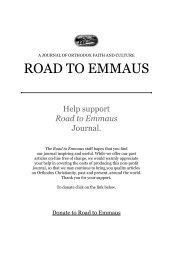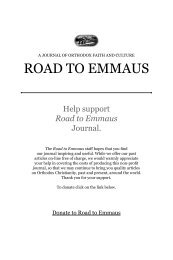RTE No 20 Interior - Road to Emmaus Journal
RTE No 20 Interior - Road to Emmaus Journal
RTE No 20 Interior - Road to Emmaus Journal
You also want an ePaper? Increase the reach of your titles
YUMPU automatically turns print PDFs into web optimized ePapers that Google loves.
<strong>Road</strong> <strong>to</strong> <strong>Emmaus</strong> Vol. XII, <strong>No</strong>. 1 (#44)TITLE<strong>RTE</strong>: Yes. Can you speak now about some of the major events you witnessed,feastdays and the reopening of churches?Igumen Melchisedek: One liturgy that stands out in my mind is that ofTransfiguration, August 6/19th of 1988, when so many people came <strong>to</strong> Optinathat they couldn’t all fit in<strong>to</strong> the belfry chapel, so we decided <strong>to</strong> serve outside.The pilgrims s<strong>to</strong>od in the street and a staircase was built from the lowerpart of the <strong>to</strong>wer (which used <strong>to</strong> be the monastery’s main entrance) up <strong>to</strong> thelevel of the second-floor chapel in the bellfry. At the <strong>to</strong>p of the steps a landingwas built, where the priest s<strong>to</strong>od—you couldn’t see in<strong>to</strong> the altar because itwas enclosed by the iconostasis—then, there were more steps up <strong>to</strong> the cross.The people s<strong>to</strong>od on the ground, with the cross at the <strong>to</strong>p and the priest inthe middle. It was at that service that I unders<strong>to</strong>od that the priest is just anintermediary between heaven and earth.The first liturgy served at the central altar of the Church of the Presentationof the Mother of God was on the Feast of the Dormition on the 15/28thof August, 1988. This has always been the main church of the monastery,and it is as large as some city cathedrals. We had already been using the sidealtar, dedicated <strong>to</strong> St. Nicholas, but this service was a real joy, because itwas the first time we were able <strong>to</strong> serve in the main altar. After the service,the namestnik asked, “Is it possible that by the feastday of St. Amvrosy, (the23rd of Oc<strong>to</strong>ber), we can res<strong>to</strong>re the whole church?” The feast was less thantwo months away and there was an immense amount of work <strong>to</strong> be done, butI said, “We have <strong>to</strong> try.”Then it started—we worked day and night. A week before the feast, we senta bus <strong>to</strong> Kaluga <strong>to</strong> bring the diocesan seminarians and a truck for beds fromthe nearest military post for the pilgrim workers. There was only a weekleft until the feast, and during this week about a hundred people came <strong>to</strong>work nons<strong>to</strong>p on the church. Everyone was doing something. To keep thework organized, the head of the project s<strong>to</strong>od in the middle of the church fortwo or three days, saying, “Put this here, take that there. Put the floor here,the iconostasis there.” It was like an anthill. By St. Amvrosy’s feastday, thechurch was ready. It was whitewashed, the marble floor had been laid, andall of the icons were up. It was a blessing from God.So many people came for that first liturgy that they couldn’t fit in<strong>to</strong> thechurch. It was the first feast of St. Amvrosy’s repose in the reopened monastery,and in that last week, as we were working so hard, his relics were found.Opposite: Ruined Church of St. Mary of Egypt, Optina Monastery, 1965.<strong>20</strong>21










